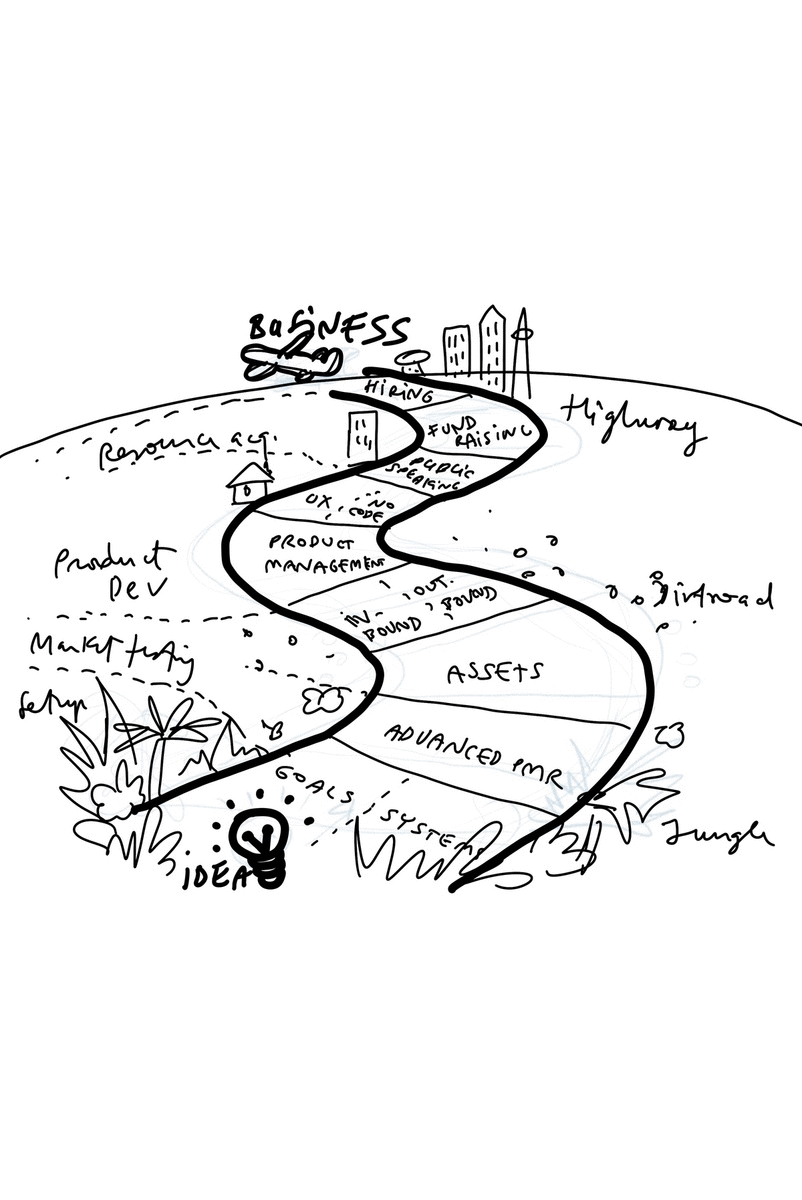Making the Map
Introduction
The entrepreneurship journey is tumultuous and fraught with numerous challenges. Having a guide or a roadmap doesn't make the journey easy, but it can make it clearer. This is the philosophy that fueled the creation of the Startup Tactics map for the book Disciplined Entrepreneurship: Startup Tactics. The map does not just represent tactics, but embodies MIT's perspective on entrepreneurship, rooted in real-world challenges and experiences.
The Startup Tactics map is a work of art that simplifies a complex entrepreneurial process with the goal of making the process both approachable and digestible. It is the representation of a process that took years of refinement from feedback and actual results. Over two years the process was structured into the current shape through the Venture Creation Tactics course at MIT. Then, we received feedback from a broader audience on LinkedIn. With the inspiration from the course and input from entrepreneurs on LinkedIn, the next six months were spent turning the structure into a visualization with illustrator Marius Ursache. Back to the public for feedback, several options were shared on LinkedIn to gather additional input.
Marius’s expertise was invaluable in bringing this roadmap to life. The challenge was not merely representing the tactics, but encapsulating the essence, the interrelations, and the dynamic nature of entrepreneurship. The roadmap had to be more than just a static flowchart; it had to be a narrative. The hues chosen, the visual metaphors employed, and the layout all had purpose. For instance, the progression from the bottom to the top signifies the journey's nonlinear trajectory, reflecting the ups and downs, twists and turns of the entrepreneurial journey.
Evolution
Through 23 distinct versions, the final illustration was designed with the intent of serving as a follow on to the steps presented in Disciplined Entrepreneurship.
It shows a structured process, but one that does not follow a “straight road” knowing that there will be many twists and turns as the business evolves. Each of the tactics relate to each other and are not necessarily valuable in isolation.
Another crucial aspect of the Tactics map is the feedback loops. Entrepreneurship is iterative. The lessons learned from one stage might require revisiting earlier tactics or reshuffling priorities. This flexibility is subtly showcased in the map, reminding entrepreneurs of the importance of adaptability. It is not “one and done,” instead each tactic is applied once and continues on forever. You’ll notice that the stages each run through until the end because entrepreneurs need to constantly be using each. For example, they must set goals at the beginning, always refer back to them to stay on track, and refine the goals over time.
Final Roadmap Illustration
The finalized roadmap illustration seeks to convey four distinct stages:
The Foundations, representing Stage 1, are depicted first at the bottom of the illustration. You’ll find entrepreneurs here with little structure and a lack of direction. They know where they are trying to go because they are equipped with a business plan from the 24 Steps in Disciplined Entrepreneurship. Here is where they build the foundation upon which all of the subsequent tactics will be applied.
The second stage, Market Testing, occurs once the entrepreneurs have some sense of structure with their goals set and systems in place. This is the dirt road. The entrepreneurs are looking for evidence that they have something real. They are looking for customers who have a common problem. This experiments run in this stage of the entrepreneurial process result in real customers.
With customers lined up to use the product, the next stage, Product Development, is on the brick road. Customers demonstrate real traction. With that real traction the entrepreneurs are in build mode and have a good deal of direction and structure to move forward.
Now that the entrepreneurs have foundations, customers, and a product built they move to the highway with resource acquisition. This is where they take their hypotheses and traction and convince others to supply additional resources in the form of time and money. Money through additional fundraising and time with new recruits joining the team. It is here that the entrepreneurs have a clear path to success and are competing in the marketplace alongside other organizations.
In the distance beyond the tactics the entrepreneurs have escape velocity, a term we use to indicate that they have what they need to continue on as a successful startup. This escape velocity is represented in the rocket taking off into space on a trajectory to reach the entrepreneurs’ north star.
Uses
While the book and its tactics are valuable, the visual roadmap amplifies its impact. It serves as a quick reference, a motivational tool, and a reminder of the big picture. Entrepreneurs can pin it up on their walls, use it in their presentations, or simply glance at it during moments of doubt or decision-making.
A Constant Reminder
The roadmap serves as a constant reminder of the value of a structured process that can be applied to the development of any business. Importantly, the order of operations shines through. Learning the tactics in a specific order teaches entrepreneurs that it does not make sense to fundraise until you have a good businesss, for example. And that market testing should come before product development.
The Tactics map is not just an illustration; it is the distillation of years of experience, feedback from others, and evolution into a visual guide. It is a testament to the fact that while the entrepreneurship journey is complex, with the right tools and insights, it can be navigated with clarity and purpose. Every line, color, and stage in the map carries with it the weight of real-world trials and triumphs, making it a beacon for all budding entrepreneurs.



